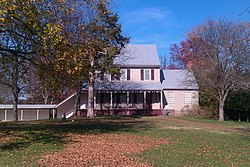Sully (Fairfax County, Virginia)
|
Sully
|
|

Sully Main House
|
|
| Location | 3650 Historic Sully Way Chantilly, VA 20151 |
|---|---|
| Coordinates | 38°54′29″N 77°25′56″W / 38.90806°N 77.43222°WCoordinates: 38°54′29″N 77°25′56″W / 38.90806°N 77.43222°W |
| Area | 65 acres (26 ha) |
| Built | 1794 |
| Website | Sully Historic Site |
| NRHP reference # | 70000793 |
| VLR # | 029-0037 |
| Significant dates | |
| Added to NRHP | December 18, 1970 |
| Designated VLR | October 6, 1970 |
Sully Historic Site, more commonly known as Sully Plantation, is both a Virginia landmark and nationally registered historic place in Chantilly, Virginia.
The earliest recorded claim to the land was made by the Doeg. Later the Lee family of Virginia owned the land from 1725 to 1839. Richard Bland Lee did not build the main house until 1794. Following the purchase by William Swartwort in 1838, Sully was used as a home, a working farm, or both by a series of private owners. Then in 1958, Sully was acquired by the federal government as a part of the area to be used for the construction of Dulles Airport. Today the Fairfax County Park Authority operates the site with a specific focus on the Lee family.
The land that would become part of Sully was likely controlled by several groups before the Doeg claimed the area. English settlers encountered Algonquian language speaking members of the Doeg tribe in modern-day Northern Virginia. The Doeg are most well known for their raid in July 1675 that became a part of Bacon's Rebellion. English colonists settling in modern Northern Virginia came into conflict with the Doeg from 1661 to 1664. When diplomatic attempts failed, the governor sent the Rappahannock County militia in June 1666. The specifics of that military action are unclear, but later land grants to English settlers are not disputed, suggesting the English gained control of the area. The English presumptively took control after a violent conflict with the Doeg in 1666. Little is recorded about the disposition of this land from the time when the English gained control of it until the land is patented by the Lee family of Virginia.
...
Wikipedia



